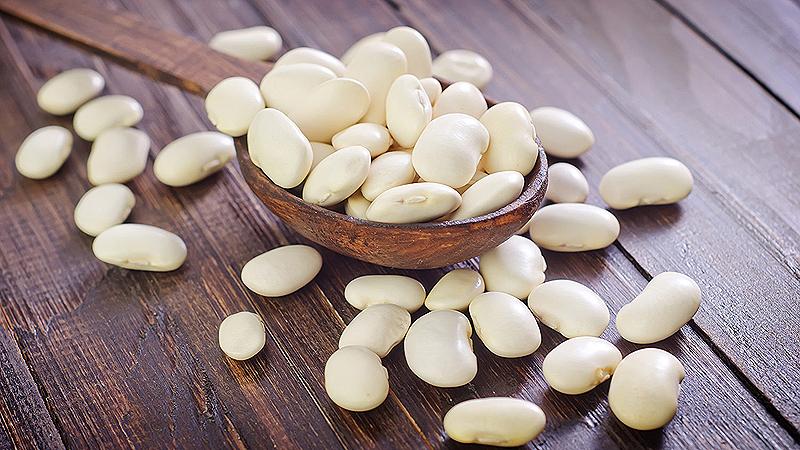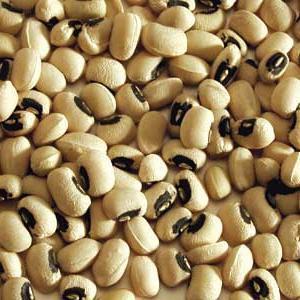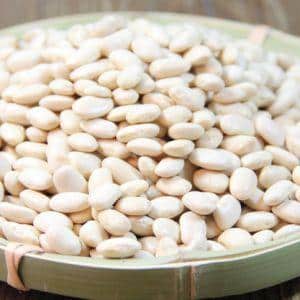Features of growing white beans
White beans - a healthy and tasty product, especially valuable for people who want to lose weight. In this article we will consider the varietal diversity of this plant, the benefits and harms of white beans. We will learn how to plant and care for seedlings correctly, and how to store the harvest.
Description and characteristics of the plant
White beans - a plant of the legume family. It grows in pods and has an oval, slightly flattened shape (this is clearly visible in the photo). Initially, it began to be eaten and cultivated in Latin America and India.

The fruits are famous for their nutritional properties. In terms of protein content, it is ahead of meat. And the calorie content is generally three times higher than it! This type will be useful for those who have problems with the liver and gall bladder. It also helps strengthen human immunity.
The average yield of this plant is 1 kg per 1 sq. m beds.
Health benefits of white beans
Compared to other species of this plant, the white variety is characterized by the highest protein content. The plant is also rich in coarse plant fibers, which do not dissolve in the human stomach and intestines, but can absorb and remove many harmful substances and toxins from the body.
Due to the content of folic acid, white beans are an effective means of preventing atherosclerosis. It also strengthens human teeth and bones, as it is rich in calcium and magnesium.
White beans It is recommended for inclusion in the diet of people with problems with the nervous system.In addition, due to the large amount of iron in its composition, it prevents the development of anemia and helps increase the body's resistance to infections and viruses.
Note. White beans have also found wide application in cosmetology, since the substances contained in them help smooth out wrinkles.
Let's note how useful white beans are for losing weight. It has the ability to “accelerate” the metabolism in the body. This makes it an extremely useful product for those who are trying to lose weight.
Harm from white beans
Elderly people, as well as those who suffer from nephritis and gout, should avoid eating it. This is due to the fact that the fruits contain a significant amount of purines. We advise people with diseases such as ulcers, pancreatitis, gastritis, cholecystitis to use white beans with caution. In addition, this culture can cause increased gas formation in the intestines.
Popular varieties of white beans
Let's look at the three most popular varieties white beans.
Navy
The variety is rich in iron and fiber. Its fruits are quite small, milky white in color. It is most widespread in America. The variety is ideal for dietary nutrition. Pairs best with vegetables and herbs. Cook it quickly. Has a pleasant aroma.
Chali
The variety is common in Turkey and some Asian countries. It has a high content of calcium and potassium. The content of these elements does not decrease even after boiling.
Lima beans
It grows mainly in South America. The fruits resemble small tangerine slices. It has a delicate creamy taste. Recommended mainly for stewing and frying.
Growing and caring for white beans
The plant loves warmth and grows best in mild climates. We recommend sowing it at the end of May, beginning of June, that is, when the night frosts end. Before sowing, you need to place the grains in water and wait until they swell.
Seeds are sown in loosened soil with neutral acidity. Planting depth is about 3 cm. For every square meter of bed, about 30 plant seeds are used. 2 months after the emergence of seedlings, you can begin harvesting. To get the harvest earlier, you can sow at home in early May.
Plant care is standard: weeding, loosening and sufficient watering. It is also advisable to apply special mineral fertilizers.
Important. Under no circumstances should you use fresh manure for feeding.
Prevention of diseases and pests
The most common bean diseases are anthracnose, root rot, white rot, powdery mildew, and bean mosaic. To prevent these diseases, crop rotation is used, with a return to the previous planting site no earlier than after 4-5 years.
In the fall, the area that will be sown with beans in the spring is cleared of weeds, dug up and potassium and phosphorus fertilizers are applied. IN During the growing season, mineral fertilizers that do not contain nitrogen are used (for example, potassium chloride, potassium sulfate, superphosphates, phosphate rock). For sowing, it is best to use treated seeds. They also use warming the seeds before planting with warm air (50-60 degrees).
The main pests of beans are aphids, whiteflies, sprout flies and bean kernels. To prevent their appearance, bean seeds are pickled in peroxide or a solution of potassium permanganate before planting.Pests do not tolerate the smell of garlic and dill, so you can plant these plants next to the beans.
If these methods of protection do not help, use chemical preparations: “Decis” or “Aktara” (treat once before flowering); “Verticillin” or “Haupsin” will also help (treat 2 times: before and after flowering).
To avoid crop loss, harvest beans before the fruit begins to crack. After this, it is recommended to put the harvested crop in the freezer at a temperature below -10°C for 3-4 days.
Attention! Beans are stored in a cool place in tightly closed jars.
Conclusion
White beans are a healthy and nutritious product. Contains a huge amount of useful substances and vitamins and is suitable for dietary nutrition. Calorie content of boiled beans is 298 kcal.
The content of proteins, fats and carbohydrates (BJU) per 100 g of product is 20.9 g, 1.8 g, 64 g, respectively. Growing this plant is quite simple, you just need to follow the rules we described.